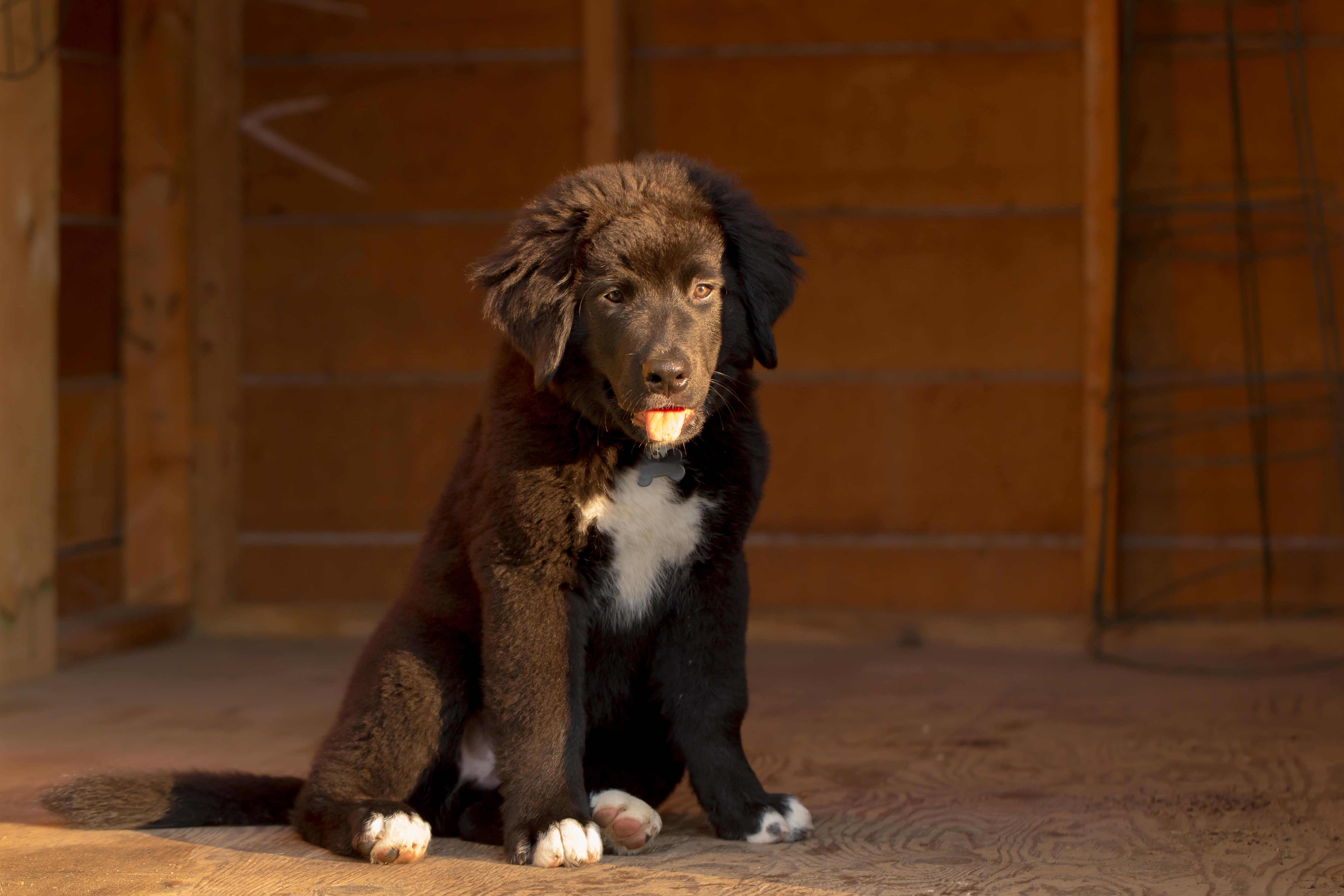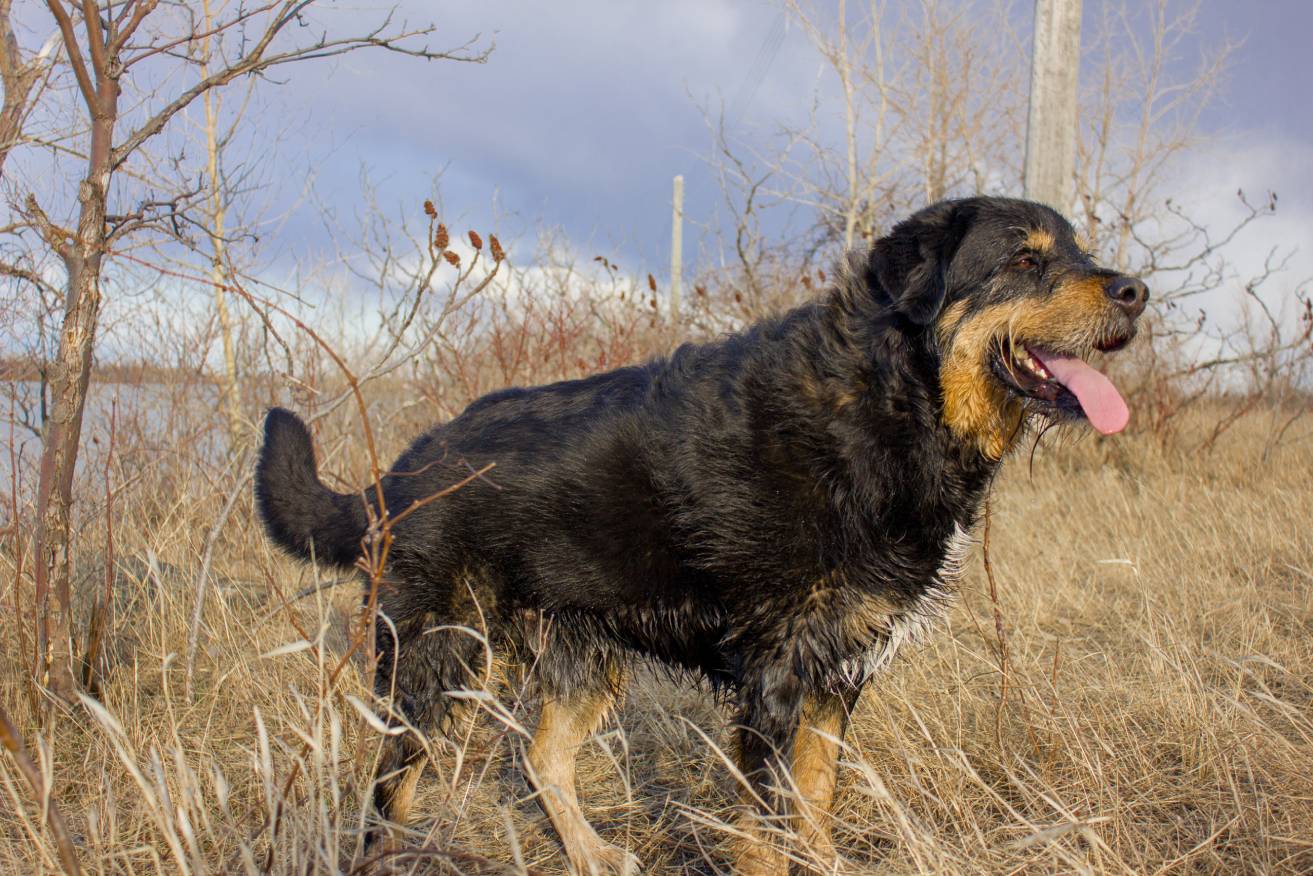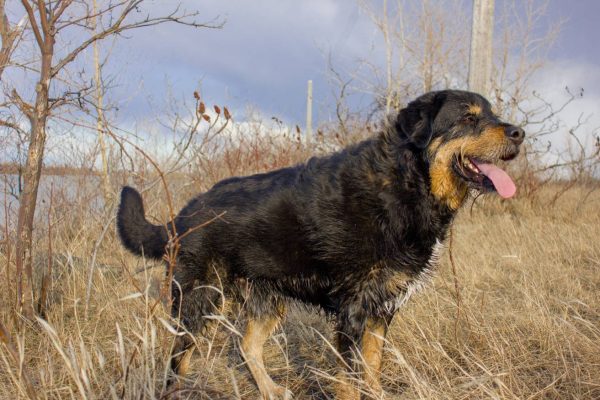Click Below to Skip Ahead
A Labernese is a mix between a Labrador Retriever and a Bernese Mountain Dog. This mixed breed is known for being quite large. They are often decently larger than a purebred Labrador Retriever – in both height and bulk.
However, they often retrain the friendly nature of each of their parent breeds. They’re laidback animals that love their families. They are incredibly devoted and quite intelligent, making them easy to train.
Breed Overview
Height:
65 – 105 pounds
Weight:
24 – 26 inches
Lifespan:
8 – 10 years
Colors:
Many varieties
Suitable for:
Active families with children
Temperament:
Devoted, gentle, intelligent
Many owners describe these dogs as affectionate. They often have excellent house manners and tend to spend a lot of their time inside lying around.
With that said, they do require a bit more work than other breeds. For instance, they require significant amounts of grooming in most cases, plenty of mental stimulation, and regular exercise. They are not for the faint of heart or casual dog owners.
To find out if this is the right breed for you, keep reading!
Labernese Puppies

It can be reasonably difficult to find Labarnese dogs. They are not often produced by breeders, as they are a mixed breed. Some mixed breeds have taken off in popularity and now have several breeders dedicated to them. However, this breed does not fit into that category. Most breeders who produce these dogs specialize in one of the parent breeds. Breeding a few litters of this mixed breed is an afterthought.
Sometimes, you may be able to find this breed at a shelter or rescue. Usually, these dogs are the result of an accidental litter. A Burmese Mountain Dog and a Labrador Retriever accidentally got together, creating a litter of mixed-breed puppies. The price often depends on the amount of medical care the dog needs – so puppies often cost more than adults.

Temperament & Intelligence of the Labernese
The Labernese is usually described as a gentle giant. They tend to be very laid back and spend much of their time lying around. Their manners inside are excellent – mainly because they like to pick a spot on the floor and stay there.
For families looking for a laid-back companion, this canine may be precisely what you’re looking for.
These dogs are also quite intelligent. They learn quickly and are people-oriented enough to want to please. They will generally learn commands quickly and also listen to them in real-life situations. This dog is not difficult to train in the least.
However, they are prone to separation anxiety. As puppies, they need to be taught to be alone, starting at a relatively young age. Crate training is crucial for this breed, especially considering their colossal size!
If they develop separation anxiety, the destruction they can cause is massive.
These canines should always be trained following science. Positive reinforcement training is often your best option.
Are These Dogs Good for Families?
As long as you can keep up with their mental and physical exercise needs, these dogs are often great for families.
Their large, laidback nature makes them the perfect choice for families with children. They are often large enough to put up with a lot of children.
The Labernese is plenty large enough to avoid being hurt by more minor children. Because of this, fear-based biting is less likely. These dogs are big enough that most small children can’t hurt them in the least.
However, that doesn’t necessarily mean that you should leave children alone with them unsupervised. They are dogs and can be unpredictable in their way.
Does This Breed Get Along with Other Pets?
When socialized correctly, this breed can quickly get along with other pets. In most cases, they aren’t territorial around other dogs, especially if they are taken around other dogs starting at an early age. Of course, there will be a decent amount of personality differences between dogs.
Some will get along with other dogs more than others. Since they are a mixed breed, this difference in temperament is likely to be more pronounced.
With that said, they aren’t often a good choice for homes with cats and other small animals. They can have a bit of a prey drive, which cannot be “trained out.” Plus, their large size makes this particularly complicated.
Do you want a 100-pound dog potentially chasing a cat around your house?
Things to Know When Owning a Labernese:
Food & Diet Requirement
Because they are large dogs, the Labernese has specific dietary requirements.
They take a lot longer to grow than other breeds, especially those on the bigger end of the spectrum. For this reason, we do recommend puppy food specifically designed for larger dogs. These canines have specific dietary needs to ensure that they develop correctly.
For instance, large breed puppies need lower levels of calcium than other dogs. Otherwise, they may develop hip dysplasia later in life.
Their calorie intake should also be kept in check. While they are growing, these puppies should be kept lean but healthy. Too much weight can make them grow more quickly, putting excess pressure on their joints and causing growth abnormalities.
After puppyhood, we recommend continuing with food designed explicitly for large-breed dogs. Glucosamine and omega fatty acids can help avoid joint problems, which are very common in larger breeds.
Exercise
While these dogs may be huge and laidback, that doesn’t necessarily mean they don’t require plenty of activity. These dogs are incredibly active, largely thanks to their Labrador parentage. However, different dogs need different amounts of exercise.
Some dogs will be highly active, especially if they are smaller. Other dogs will be more laid back and spend more time lying around. However, all Labernese will need at least some exercise each day.
Often, these dogs love water and any canine sport. They do well in obedience and agility training, where their high activity needs combine with their eager-to-please nature. If you’re interested in canine sports, this dog breed may be the perfect option for you.
While they are a bit hairy, that doesn’t necessarily mean that they don’t do well in warmer climates. Their double coat does a reasonably good job of keeping them cool and warm. However, you shouldn’t exercise them in scorching weather – just like you wouldn’t want to exercise in sweltering weather.
This canine can do well in apartments as long as their exercise needs are met. Their house manners are excellent, so they often don’t cause much of a fuss indoors.
Plan on giving them at least an hour or moderate to intense exercise a day.
Training
The Labernese trains easily and quickly. They are brilliant and eager to please. Their people-oriented nature means that they just want to make their owners happy, making them perform very well in training.
These dogs are smart enough to learn most commands quickly. Both the Labrador Retriever and Burmese Mountain Dog were bred to work alongside people. Therefore, listening to commands is part of their blood.
However, proper training and socialization are still required. We highly recommend puppy classes as soon as they are old enough, providing training and socialization. If you adopt an older dog, group classes are usually the best option.
Individual training classes often cost more – but that doesn’t mean that they are a better option. Group classes provide socialization, while individual training classes do not. You get more bang for your buck when it comes to group classes.
This breed can be trained for specialty work. They may be suitable for working with people with disabilities, for instance. They are also excellent at more canine sports, including those with water.
Grooming ✂️
The Labernese do need a bit of grooming. Most importantly, they need to be brushed at least a few times a week to help keep their coat clean. This routine should be maintained even if they have shorter hair.
No matter their hair length, the Labernese will shed quite a bit. They require brushing to remove much of their hair, though brushing also removes dirt and debris. During certain times of the year, you can expect them to shed even more than usual.
This phenomenon is called “blowing their coat” and usually occurs when the seasons change. It’s hormonally driven, though, so it may not exactly line up with the seasons as you would imagine.
During this period, they may need to brush as much as once a day. You’ll only need to keep up with this extra brushing while they are shedding extra, though.
You shouldn’t need to bathe these dogs very often. A regular brushing routine will do a great job of keeping them clean. However, every dog is going to roll in the mud at least once! With their long fur, this situation almost certainly requires a bath!
Use a gentle shampoo any time these dogs need to be bathed. We also recommend keeping an eye out for skin irritation and similar issues. While these dogs are particularly prone to skin problems, it doesn’t take much for most dogs to get itchy.
Due to their long fur and floppy ears, this breed can develop ear infections. Be sure to keep the inside of their ears cleaned and trimmed. The longer fur can trap dirt and debris, which will eventually lead to infections. Trimming the fur in the ears does help prevent this, though.
You should carefully clean their teeth regularly as well. Periodontal disease is a severe problem for dogs. While it does directly affect their teeth, it can also lead to other problems. For instance, the gums are a fast way for bacteria to enter the bloodstream. If the gums become infected, the infection can quickly travel around to other areas of the dog’s body.
Health and Condition
As a mixed breed, this dog tends to be healthier than most. Mixed breeds are less likely to inherit genetic conditions since they are inheriting from a larger gene pool. However, that doesn’t mean that this breed is entirely healthy.
They are still prone to a few different conditions.
The primary concern with the Labernese is their joints. Like most large dogs, they are prone to hip dysplasia. This condition occurs when the hip does not grow correctly. The mismatch of the joint causes extra wear starting in puppyhood, leading to arthritis at a very early age.
Usually, this condition causes pain and movement difficulties before the age of four. It’s progressive, so it only gets worse as the dog ages. Treatment is required to keep the dog healthy and prevent further progression as the dog ages.
Bloat may also occur. Again, this disease occurs most commonly in larger dogs. The Labernese is absolutely a giant dog, so it may occur in them with some frequency. Larger Labernese may be more prone to this issue than smaller ones.
This condition is life-threatening and requires emergency veterinary treatment. Surgery is required to dispel gases that have built up in the stomach. Otherwise, the stomach can begin to press up against other organs and tissues, cutting off blood flow and causing them to die.
- Ear infections
- Arthritis
- Bloat
- Hip dysplasia
- Cancer
- Heart conditions
Male vs. Female
There is no significant difference between the males and females of this breed. Males may be slightly larger, but the size difference varies so much that you likely won’t notice. Many females will be larger than males simply because they inherited more genes from their Burmese Mountain Dog parent.
Temperament is pretty similar between both genders as well. Again, any differences are likely due to genetic variations and socialization – not gender.
Gender shouldn’t play a massive role in deciding what dog to get. However, some people do have a gender preference. Just be aware that this may elongate the time it takes for you to find an appropriate puppy.
Given their rarity, it is often best to adopt whatever dog comes along. If you’re set on a specific gender, you may never have the time to adopt one of these canines.

3 Little-Known Facts About the Labernese
1. Their Traits Aren’t Exactly Set in Stone
You’ll hear a lot about Labernese acting or looking a certain way. However, these dogs are much less predictable than other breeds. As a mixed breed, they’re inheriting from a larger gene pool. Therefore, their size range and personality range are huge. If you’re looking for a dog that will end up a certain way, purchasing a mixed breed is probably not the best option.
2. They Aren’t Low-Maintenance
These canines can make good family dogs. They’re friendly and affectionate. However, they also require a lot of work. You need to groom them, exercise them, and mentally stimulate them. If you don’t do this, they can be destructive.
3. They Are Rare
Both Labrador Retrievers and Burmese Mountain Dogs are somewhat familiar in the United States, so you would think this breed would be too!
However, that isn’t the case. This mixed breed is not highly sought after, so they usually aren’t bred on purpose. This fact makes them quite rare in most situations.
Final Words
The Labernese is a reasonably large dog that makes a great family companion. They are incredibly loving and devoted to their families. They often spend much of their time cuddling and lounging around with their people.
However, they also require quite a bit of work. For instance, they need at least an hour of exercise daily. Despite their large size, they aren’t precisely “rug dogs.” We recommend them primarily for active families for this reason.
They also require a significant amount of grooming. Without this grooming, they can become matted and dirty.
If you can put in the work required, these dogs can make an excellent addition to most families. They get along well with children, as well as other dogs if they are properly socialized.
Related Reads:
- Labbe (Labrador Retriever & Beagle Mix)
- Petite Goldendoodle (Labrador Retriever, Poodle & Cocker Spaniel Mix)
Featured Image Credit: Elodie Photography, Shutterstock











